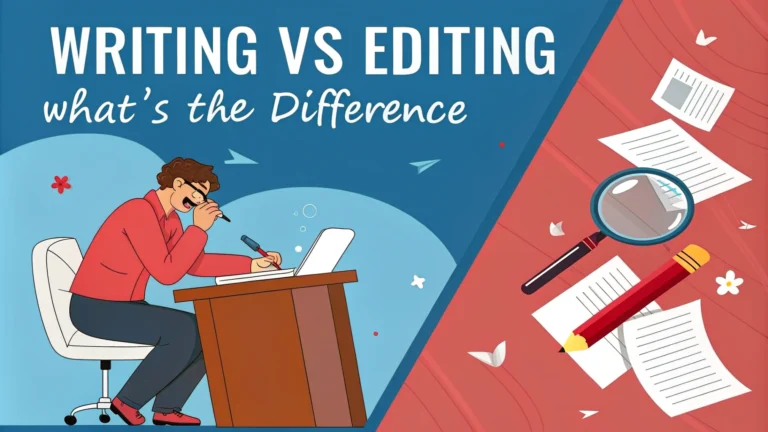Many writers struggle to distinguish between writing and editing – two distinct but complementary skills in content creation. Writing focuses on getting ideas onto paper, while editing refines those ideas into polished content.
Each process requires different mindsets and approaches. **Writing** demands creativity and free flow of thoughts, whereas **editing** calls for analytical thinking and attention to detail.
The Creative Flow of Writing
The writing process centers on **idea generation** and **storytelling**. Writers need freedom to explore thoughts without judgment, focusing on:
- Capturing raw ideas and concepts
- Developing narrative structure
- Creating original content
- Expressing thoughts naturally
The Technical Art of Editing
Editing transforms rough content into refined work through:
- Grammar and punctuation checks
- Sentence structure improvements
- Content organization
- Clarity enhancement
> “Writing is the painting of the voice; editing is the frame that displays it perfectly.”
Essential Tools and Techniques
**Writing tools** and **editing software** serve different purposes:
| Writing Tools | Editing Tools |
|---|---|
| Google Docs | Grammarly |
| Scrivener | Hemingway Editor |
| Microsoft Word | ProWritingAid |
Setting Clear Boundaries Between Writing and Editing
Content quality suffers when writers mix writing and editing tasks. Understanding when to focus on each activity helps create better work with less stress.
Strategic Timing for Each Phase
**Writing sessions** work best during peak energy hours when creativity flows naturally. Schedule focused blocks of 25-45 minutes for writing, followed by short breaks.
**Editing** requires sharp analytical skills, making it ideal for:
- Mid-morning hours after coffee
- Early afternoon after lunch
- Times when creativity feels lower
Building an Effective System
Create separate workflows for writing and editing tasks:
| Writing Phase | Editing Phase |
|---|---|
| Turn off spell check | Enable all editing tools |
| Focus on quantity | Focus on quality |
| Skip formatting | Apply style guides |
Common Workflow Issues
Watch for these frequent problems:
- Editing while writing first drafts
- Skipping the cooling-off period between phases
- Using the wrong tools for each task
- Not setting clear goals for each session
> “Separate your writing and editing sessions like you separate your laundry – mixing them only creates a mess.”
Next Steps for Implementation
Start with these practical steps:
- Set specific times for writing and editing
- Choose appropriate tools for each task
- Create checklists for both processes
- Track results and adjust as needed
Remember that improvement comes through consistent practice and deliberate separation of these two key skills. Focus on one task at a time for better results in both areas.
Writing vs Editing FAQs
General FAQs
Q: What is the main difference between writing and editing?
A: Writing is creating original content from scratch, while editing involves reviewing, correcting, and improving existing written content. Writing focuses on getting ideas down, while editing refines those ideas for clarity and effectiveness.
Q: Can someone be good at both writing and editing?
A: Yes, many professionals excel at both, but most people naturally lean toward one skill. Good writers aren’t always good editors, and vice versa, as each requires different mindsets and skill sets.
Q: Which comes first: writing or editing?
A: Writing always comes first. You need content to exist before it can be edited. The writing process focuses on creation, while editing is about refinement.
Long-tail Keyword FAQs
Q: How much does a professional editor charge per word?
A: Professional editing rates typically range from:
- Basic proofreading: $0.01-0.02 per word
- Copy editing: $0.02-0.04 per word
- Developmental editing: $0.08-0.15 per word
Q: What are the 4 types of editing?
A: The main types are:
- Developmental editing (big-picture structure and content)
- Copy editing (grammar, style, consistency)
- Line editing (writing style and language use)
- Proofreading (final review for errors)
Q: How long should I wait between writing and editing?
A: Most professional editors recommend waiting at least 24-48 hours between writing and editing. For longer works like books, waiting 1-2 weeks is optimal.
Q: What tools do professional editors use?
A: Common editing tools include:
- Microsoft Word with Track Changes
- Grammarly
- ProWritingAid
- Chicago Manual of Style
- AP Stylebook
Q: What qualifications do you need to become an editor?
A: Standard requirements include:
- Bachelor’s degree in English, Journalism, or related field
- Strong grammar and writing skills
- Attention to detail
- Experience with style guides
- Portfolio of edited work
Q: How many rounds of editing does a book need?
A: Most books require 3-4 rounds of editing:
- Developmental edit
- Line edit
- Copy edit
- Final proofread
Q: What is the average writing speed vs editing speed?
A: Average speeds:
| Task | Speed |
|---|---|
| Writing | 500-1500 words per hour |
| Basic editing | 1000-2000 words per hour |
| Deep editing | 250-500 words per hour |



















